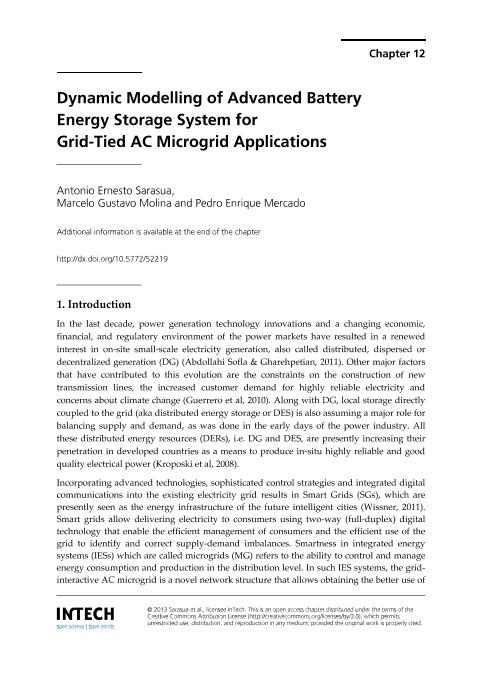Capítulo de Libro
Dynamic modelling of advanced battery energy storage system for Grid-Tied AC microgrid applications
Título del libro: Energy Storage: Technologies and applications
Sarasua, Antonio Ernesto; Molina, Marcelo Gustavo ; Mercado, Pedro Enrique
; Mercado, Pedro Enrique
 ; Mercado, Pedro Enrique
; Mercado, Pedro Enrique
Otros responsables:
Zobaa, Ahmed F.
Fecha de publicación:
2013
Editorial:
IntechOpen
ISBN:
978-953-51-0951-8
Idioma:
Inglés
Clasificación temática:
Resumen
In the last decade, power generation technology innovations and a changing economic, financial, and regulatory environment of the power markets have resulted in a renewed interest in on-site small-scale electricity generation, also called distributed, dispersed or decentralized generation (DG). Other major factors that have contributed to this evolution are the constraints on the construction of new transmission lines, the increased customer demand for highly reliable electricity and concerns about climate change. Along with DG, local storage directly coupled to the grid (aka distributed energy storage or DES) is also assuming a major role for balancing supply and demand, as was done in the early days of the power industry. All these distributed energy resources (DERs), i.e. DG and DES, are presently increasing their penetration in developed countries as a means to produce in-situ highly reliable and good quality electrical power. Incorporating advanced technologies, sophisticated control strategies and integrated digital communications into the existing electricity grid results in Smart Grids (SGs), which are presently seen as the energy infrastructure of the future intelligent cities. Smart grids allow delivering electricity to consumers using two-way (full-duplex) digital technology that enable the efficient management of consumers and the efficient use of the grid to identify and correct supply-demand imbalances. Smartness in integrated energy systems (IESs) which are called microgrids (MG) refers to the ability to control and manage energy consumption and production in the distribution level. In such IES systems, the grid-interactive AC microgrid is a novel network structure that allows obtaining the better use of DERs by operating a cluster of loads, DG and DES as a single controllable system with predictable generation and demand that provides both power and heat to its local area by using advanced equipments and control methods. This grid, which usually operates connected to the main power network but can be autonomously isolated (island operation) during an unacceptable power quality condition, is a new concept developed to cope with the integration of renewable energy sources (RESs). Grid connection of RESs, such as wind and solar (photovoltaic and thermal), is becoming today an important form of DG. The penetration of these DG units into microgrids is growing rapidly, enabling reaching high percentage of the installed generating capacity. However, the fluctuating and intermittent nature of this renewable generation causes variations of power flow that can significantly affect the operation of the electrical grid. This situation can lead to severe problems that dramatically jeopardize the microgrid security, such as system frequency oscillations, and/or violations of power lines capability margin, among others. This condition is worsened by the low inertia present in the microgrid; thus requiring having available sufficient fast-acting spinning reserve, which is activated through the MG primary frequency control. To overcome these problems, DES systems based on emerging technologies, such as advanced battery energy storage systems (ABESSs), arise as a potential alternative in order to balance any instantaneous mismatch between generation and load in the microgrid. With proper controllers, these advanced DESs are capable of supplying the microgrid with both active and reactive power simultaneously and very fast, and thus are able to provide the required security level. The most important advantages of these advanced DESs devices include: high power and energy density with outstanding conversion efficiency, and fast and independent power response in four quadrants. Much work has been done, especially over the last decades, to assess the overall benefits of incorporating energy storage systems into power systems. However, much less has been done particularly on advanced distributed energy storage and its utilization in emerging electrical microgrid, although major benefits apply. Moreover, no studies have been conducted regarding a comparative analysis of the modeling and controlling of these modern DES technologies and its dynamic response in promising grid-interactive AC microgrids applications. In this chapter, a unique assessment of the dynamic performance of novel BESS technologies for the stabilization of the power flow of emerging grid-interactive AC microgrids with RESs is presented. Generally, electrochemical batteries include the classic and well-known lead-acid type as well as the modern advanced battery energy storage systems. ABESSs comprise new alkaline batteries, nickel chemistry (nickel-metal hydride?NiMH, and nickel-cadmium?NiCd), lithium chemistry (lithium-ion?Li-Ion, and lithium?polymer-Li-po), and sodium chemistry (sodium-sulfur?NaS, and sodium-salt?NaNiCl). In this work, of the various advanced BESSs nowadays existing, the foremost ones are evaluated. In this sense, the design and implementation of the proposed ABESSs systems are described, including the power conditioning system (PCS) used as interface with the grid. Moreover, the document provides a comprehensive analysis of both the dynamic modeling and the control design of the leading ABESSs aiming at enhancing the operation security of the AC microgrid in both grid-independent (autonomous island) and grid-interactive (connected) modes...
Archivos asociados
Licencia
Identificadores
Colecciones
Capítulos de libros(CCT - SAN JUAN)
Capítulos de libros de CENTRO CIENTIFICO TECNOLOGICO CONICET - SAN JUAN
Capítulos de libros de CENTRO CIENTIFICO TECNOLOGICO CONICET - SAN JUAN
Citación
Sarasua, Antonio Ernesto; Molina, Marcelo Gustavo; Mercado, Pedro Enrique; Dynamic modelling of advanced battery energy storage system for Grid-Tied AC microgrid applications; IntechOpen; 2013; 295-320
Compartir
Altmétricas
Items relacionados
Mostrando titulos relacionados por título, autor y tema.
-
Cabello, Javier Martin ; Roboam, Xavier; Junco, Sergio Jose; Bru, Eric; Lacressonniere, Fabien (Institute of Electrical and Electronics Engineers, 2017-11)
-
Barbosa, Lucía Isabel ; Luna Lama, Fernando; Gonzalez Peña, Yarivith Carolina ; Caballero, Alvaro (Wiley VCH Verlag, 2020-02)
-
Avila, Luis Omar ; Errecalde, Marcelo Luis; Serra, Federico Martin ; Martínez, Ernesto Carlos (Elsevier, 2019-10)



